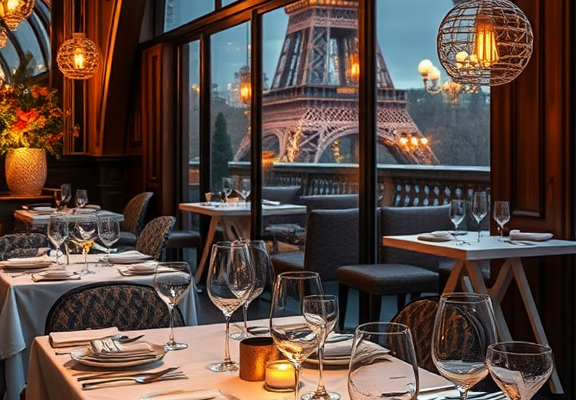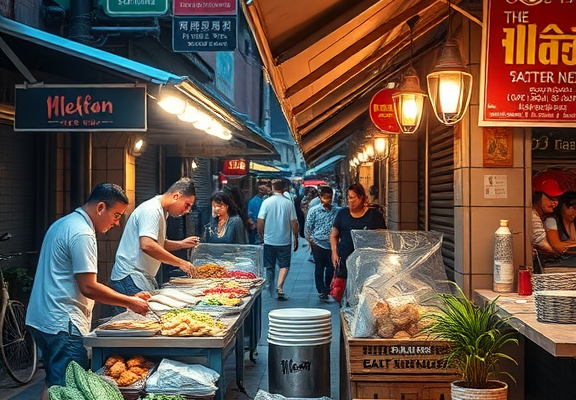Street Food vs. Fine Dining: The Culinary Experience in Singapore
When it comes to the culinary scene in Singapore, few places in the world rival its extraordinary blend of flavors and textures. Two prominent dining experiences stand out: street food and fine dining. Each offers a unique insight into Singapore’s rich culture, yet they cater to very different tastes and occasions. Let’s explore the vibrant world of street food and the exquisite realm of fine dining in Singapore.
Thank you for reading this post, don't forget to subscribe!Understanding Street Food
Street food in Singapore is more than just a meal; it is a cultural experience that brings people together. From bustling hawker centers to food trucks, this type of cuisine showcases local flavors and traditional recipes. Here are some key aspects that define Singaporean street food:
- Affordability: One of the most attractive features of street food is its low cost, allowing everyone to enjoy delicious meals without breaking the bank.
- Diversity: The island’s history as a melting pot of cultures means street food is influenced by Chinese, Malay, Indian, and Peranakan traditions, offering a variety of tastes.
- Accessibility: Hawker centers are scattered around the city, often within walking distance, making it easy for locals and tourists to sample different dishes.
- Quick Service: Street food is known for its speed, allowing you to enjoy a satisfying meal on-the-go.
Popular street food dishes to savor include Hainanese chicken rice, chili crab, and laksa. Each bite transports you to a different place, and the vibrant atmosphere of hawker centers enhances the experience.
The Allure of Fine Dining
On the other hand, fine dining in Singapore presents a luxurious culinary adventure. These establishments prioritize not just the meal but the experience through exceptional service, ambiance, and creativity in dishes. Here are some characteristics that define fine dining:
- Exquisite Ingredients: Fine dining restaurants focus on sourcing high-quality ingredients, often featuring seasonal produce and gourmet proteins like truffles and premium seafood.
- Presentation: The artistry of plate presentation is a significant part of the fine dining experience, turning each meal into a work of art.
- Elevated Environment: Ambiance plays a crucial role; many fine dining venues offer stunning views or beautifully designed interiors to create a memorable setting.
- Impeccable Service: Guests can expect attentive, knowledgeable staff who enhance the experience through personalized service.
Some of Singapore’s fine dining highlights include eateries like Restaurant André and Odette, where chefs often create menus that reflect their culinary ethos, marrying tradition with innovation.
Comparing Experiences
While both street food and fine dining showcase Singapore’s culinary prowess, they cater to different experiences:
- Cost: Street food is budget-friendly, while fine dining can be a splurge, often ranging from moderate to high prices.
- Setting: Street food offers a casual, communal vibe, whereas fine dining is more structured and sophisticated.
- Meal Preparation: Street food is typically cooked quickly in front of you, creating a lively atmosphere, while fine dining dishes are crafted with meticulous care over a longer duration.
- Occasion: Street food is perfect for casual outings or late-night cravings, while fine dining is ideal for special occasions or romantic dinners.
Ultimately, the choice between street food and fine dining in Singapore depends on what you’re craving at that moment. If you seek the heart of local culture and a taste of authentic flavors, street food is your best bet. But for those special occasions where you want to indulge and enjoy culinary artistry, fine dining will captivate your senses.
Both dining experiences enrich Singapore’s vibrant food scene, making it a top destination for food lovers. Whether you find yourself slurping up a steaming bowl of noodles at a hawker center or savoring an elegantly plated dish in a high-end restaurant, you are sure to leave with lasting memories of Singapore’s culinary delights.
The Cultural Significance of Street Food in Singapore’s Food Scene
In the vibrant food scene of Singapore, street food holds a special place that reflects the multicultural tapestry of the country. From the bustling hawker centers to open-air food markets, street food offers a unique culinary experience that embodies the rich history and cultural influences of the nation. The delicious offerings, affordability, and accessibility make it an integral part of daily life for locals and tourists alike.
Street food in Singapore is not just about taste; it tells stories of tradition and heritage. It showcases flavors from various cultures such as Chinese, Malay, Indian, and Peranakan. Each dish captures the essence of its origins while often evolving to create a distinctly Singaporean twist. For example, the beloved Hainanese chicken rice originally hails from Hainan, China, but has become a national dish that reflects a unique blend of cooking techniques and flavors. Similarly, dishes like roti prata and laksa have roots in Indian and Malay cuisines but have been adapted to local palates.
One of the essentials of Singaporean street food is the hawker centers. These are communal dining spaces filled with numerous stalls offering a diverse range of dishes. Here, culinary traditions come together in a lively atmosphere, inviting people from all walks of life to connect over food. This communal aspect not only promotes social interaction but also strengthens the bonds between various cultural communities in Singapore.
The affordability of street food is another significant factor contributing to its cultural importance. With most dishes priced affordably, anyone can enjoy a delicious meal without breaking the bank. This equal access ensures that street food continues to be a part of everyday life, allowing Singaporeans from different socioeconomic backgrounds to indulge in the same culinary experiences. The government has recognized this and actively promotes hawker culture as a vital aspect of the national identity.
The role of street food extends beyond mere sustenance; it is a reflection of Singapore’s identity and resilience. In recent years, the country has seen an influx of food entrepreneurs who are passionate about preserving traditional recipes while incorporating modern techniques. This blend of old and new attracts food enthusiasts and helps the next generation appreciate the rich culinary heritage of their culture.
Street food also plays a significant role during festivals and public gatherings in Singapore. Food stalls line the streets during events such as the Lunar New Year and Hari Raya, bringing the community together in celebration. During these times, beloved dishes are showcased showcasing the local flavors that associate with festive traditions. This cultural convergence illustrates how deeply intertwined food is with Singaporean identity and collective memory.
When you think of a visit to Singapore, the diverse culinary landscape offered by street food is hard to ignore. Here are some must-try dishes that represent the essence of street food culture:
- Char Kway Teow: Stir-fried flat rice noodles tossed with a flavorful mix of soy sauce, egg, and bean sprouts, often topped with prawns and Chinese sausage.
- Nasi Lemak: A fragrant coconut rice dish served with sambal chili, fried crispy anchovies, peanuts, and cucumber, often accompanied by fried chicken or egg.
- Satay: Skewered and grilled meat served with a rich peanut sauce, this dish is a must-have and perfect for sharing.
- Chili Crab: This spicy and sweet crab dish embodies the island’s love for seafood, served with a rich tomato-based sauce that asks for fried mantou to soak up the goodness.
- Laksa: A spicy coconut milk curry soup filled with noodles, shrimp, and tofu, exemplifying the Peranakan culinary heritage.
Moreover, street food festivals are increasingly popular in Singapore, providing a platform for local and international chefs to showcase their talents. These events celebrate culinary diversity while promoting the importance of preserving traditional cooking methods. Attendees get a chance to sample a wide array of dishes, learn about the cooking processes, and appreciate the nuances of each cuisine.
As mobile food trends continue to rise globally, Singapore’s street food remains rooted in its vibrant history while embracing contemporary flair. The hustle and bustle of food stalls, the sizzle of hot woks, and the fragrant aromas create an unforgettable sensory experience that keeps both locals and visitors coming back for more.
Street food serves as a powerful cultural narrative within Singapore’s food scene. It embodies the blend of tradition and innovation that defines Singapore today. By appreciating these culinary offerings, one not only tastes the diverse flavors of Singapore but also immerses themselves in the shared stories and communal bonds that unite this multicultural nation.
Conclusion
As you explore Singapore’s culinary landscape, the duel between street food and fine dining unfolds as a vibrant tapestry that reflects the city-state’s rich cultural heritage. Street food stalls, with their tantalizing offerings, provide a direct connection to the diverse communities that populate Singapore. Each dish tells a story, echoing the flavors of various cultures—from Chinese to Malay and Indian—making them not just meals, but a celebration of the nation’s multicultural essence. These accessible culinary delights are loved by locals and visitors alike, showcasing the heart and soul of Singapore’s street food scene.
On the other hand, fine dining presents a captivating alternative, offering meticulously crafted dishes that elevate gastronomic experiences to new heights. With renowned chefs pushing the boundaries of creativity, fine dining in Singapore allows food lovers to savor unique interpretations of traditional flavors, often accompanied by exceptional service and elegant ambiance. For many, a fine dining experience is about more than just food; it’s an occasion that creates lasting memories.
Ultimately, whether you find yourself relishing a plate of hawker-style char kway teow or indulging in a chef’s tasting menu at a Michelin-starred restaurant, both experiences contribute significantly to Singapore’s identity as a food paradise. The choice between street food and fine dining reflects personal preferences and occasions, yet both options offer delicious insights into Singapore’s dynamic culinary world. Embracing both will allow you to truly appreciate the depth and richness of Singapore’s gastronomy, making your culinary journey in this city an unforgettable one.






